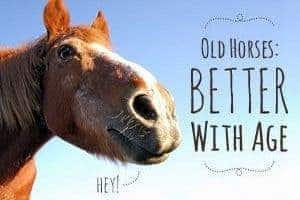The Cushingoid Senior vs. Spring Grass
- Topics: Old Horses: Better With Age
Spring has sprung in many parts of the country, and with it comes challenges for some senior horse owners. While some older horses can consume as much spring grass as their hearts desire and suffer no ill effects (my 16-year-old Thoroughbred, for example), others aren’t quite lucky. My 23-year-old Miniature Horse, Brandy, finds herself in the latter category due to equine Cushing’s disease and secondary laminitis.
Equine Cushing’s disease (also known as pituitary pars intermedia disorder, or PPID) is a hormonal disorder that impacts several body systems in affected horses. There’s no easy way to describe equine Cushing’s disease (believe me…after writing many articles on the topic, I’m still trying to figure out the best way to describe it), so if you’re not sure exactly what the disease is all about, take a look at our fact sheet on the topic.
Brandy had a history of exhibiting several clinical signs associated with equine Cushing’s disease, including an overgrown coat, a pot-bellied appearance, chronic laminitis, and increased appetite (that said, Brandy’s always had an appetite that far surpassed her small stature!). Still, she remained healthy and showed no signs of distress with the exception of recurrent laminitic episodes (which typicall lasted for a few days each, two to three times in a year), which we dealt with the help of our wonderful veterinarians. All in all, Brandy wasn’t that bad-off.
Last fall after a slight decline in health, Brandy’s veterinarian diagnosed her with Cushing’s disease and started her on low-doses of pergolide and isoxsuprine, which made all the difference in the world. She’s doing and looking better than she has in years and she hasn’t had a laminitic episode since starting her medication. In fact, she’s bounding around the farm quite happily and athletically–I haven’t seen her move that well (or fast) in many years
Create a free account with TheHorse.com to view this content.
TheHorse.com is home to thousands of free articles about horse health care. In order to access some of our exclusive free content, you must be signed into TheHorse.com.
Start your free account today!
Already have an account?
and continue reading.

Written by:
Erica Larson
Related Articles
Stay on top of the most recent Horse Health news with










